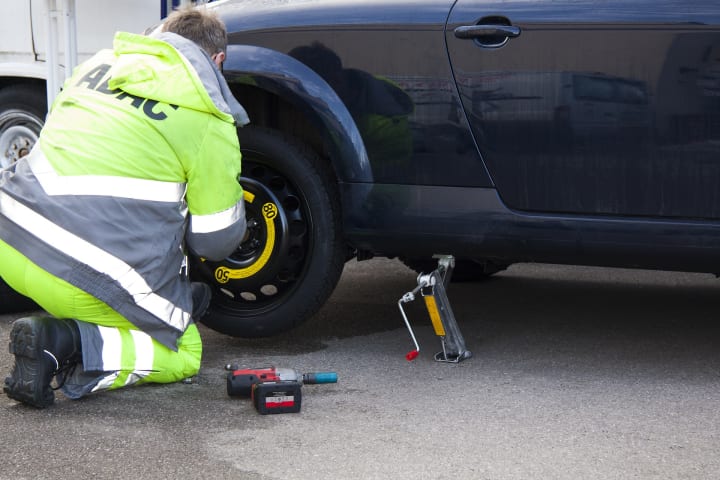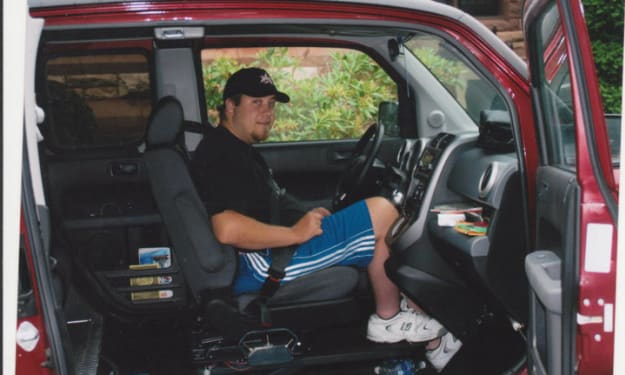The Frustrations of a Broken Wheelchair
When the one thing you NEED to in order to move, breaks.

I’m telling you, robotic legs can’t get here soon enough.
Or some sort of synthetic or bio-technical series of neural relays to bypass or serve in place of damaged spinal tissue.
Or a viable stem cell treatment to reverse the long-term paralysis caused by spinal cord injuries.
Or commercially available Iron-Man suits, minus the weapons systems (which I would use for good at first, but for sure would end up using for personal gain).
Why do I bring this up?
As I write this, I’m currently sitting in my backup wheelchair. There’s a reason why I only use it when I’m forced to.
My backup wheelchair sucks.
It’s twelve years old. The tires are bald. The front wheels wobble and make a dull clicking noise when I move. One of the rims is warped, so the brake on that side doesn’t work half the time (and even then, it barely does its job), and the seat cushion is broken down and has a hole in it.
It’s also more difficult to push because the push-rims are too close to the tires and their outer rubber coatings are littered with holes. This also means it’s harder to slow down if I get going down a hill.
If I get caught in the rain, the rims become so slick, it’s like someone coated them with Astroglide.
You’re probably thinking, “That sounds miserable. Why do you still have that hunk of crap if it’s so bad?”
Because sometimes I still need it.
Why?
If something breaks on my primary chair, I need a back-up.
And my primary chair currently has a flat tire.

***
If you’re an able-bodied person and your shoe falls apart, or you sprain your ankle, or your foot falls off, or whatever happens to able-bodied people to prevent them from getting around, you’d begin walking unevenly. Maybe you’d trip and fall or stumble over obstacles you normally wouldn’t. Maybe one side of your body would get overworked because it’s compensating for your imbalance.
When I get a flat tire, it’s like that side of my chair is rolling through thick mud. My chair constantly turns toward the side with the flat. Moreover, because one tire has air and the other doesn’t, my chair’s frame tilts toward the flat side.
Right now, I’m sitting on a slight, but noticeable slant. After a few minutes of leaning away from the side with the flat, I can feel the muscles in my neck, side, and back begin to strain because they’re working harder to keep me balanced. The arm and shoulder on the side with the flat have to work harder to keep me rolling in a straight line, which is challenging enough on flat surfaces.
Many able-bodied people don’t realize how uneven most of the ground is that they walk over.
Folks in wheelchairs can tell you how sloped the ground is and in which direction, even if it looks completely flat.
Sidewalks are especially sloped (for rain run-off). If I’m wheeling on a sidewalk with a flat tire, the drag on my chair created by the flat paired with the slope of the sidewalk can forcefully veer me toward the gutter-side of the sidewalk. This is a safety hazard, especially if the sidewalk has a squared/blocked edge. If my front wheel goes over that edge, so does the rest of me (I speak from experience here).
But it’s not just ground gradients that cause falling hazards. The effectiveness of my chair’s brakes depends on how inflated my tires are. The less air the tires have, the less effective the brakes are. If the tire is flat, the brake might as well not be there, as it is completely ineffective. This makes things like getting in and out of bed or the shower potentially dangerous.
I’m a C-5 incomplete quadriplegic and a larger than average human being, so if I fall, it takes all the king’s horses and all the king’s men to put me back in my chair again. And no one wants to do that if I’m wet and naked (again, I’m speaking from experience.)
***
You might be thinking, “If it’s such a problem, why don’t you…I don’t know…fix it?”
Great idea.
Except, due to the nerve damage in my hands, I don’t have the manual dexterity or grip strength to change the inner tube. Believe me, I’ve tried.
I worked at getting a new inner tube onto one of my rims for almost two hours one afternoon. I even had a set of tools specifically for changing bike tires. For the life of me, I just couldn’t get the bastard on the rim.
A friend of mine usually changes my tires and tubes for me. Shout out to my friend Shawn who, in the 16 years I’ve been in a chair, has changed out at least three-dozen tires and tubes.

So why don’t I get Shawn to pop a new tube in?
He’s busy. He works for animal control and has been working double-shifts for the last two months helping wrangle and relocate animals affected by the wildfires here in California.
Also, he’s my friend, not my employee.
But that’s ok, because I can take the tire to a bicycle shop that offers repairs and service. Only, there’s one bike shop in my general area. And they told me it would be several days before they could repair my flat, as there were over a dozen service tickets before mine.
Generally speaking, I’m happy to wait my turn.
But when it comes to something I need in order to get around without dragging myself across the ground like a slug, the issue is a little more pressing…at least from where I’m sitting.
***
Let me put it this way. Most of us need our cars to get to places we need to go — work, the grocery store, Baskin Robins, etc. Your car gets a flat tire, so you put on the spare— this undersized, emergency back-up measure that you’re not supposed to drive on for an extended period of time or drive faster than 50mph on.
The spare tire will get you to a repair shop, but not much further. And though it’s by no means a permanent solution, it’ll do for now.

Only you get to the repair shop and it’s closed. Maybe it’s a Friday, and they won’t open again until Monday morning, and you have to make do with the spare all weekend.
Or, you get to the repair place, and there’s a long line of cars before yours, and you’ll have to wait until everyone who came in before you has been serviced, regardless of the fact that it doesn’t take long to patch a flat or put on a new tire.
But you still need your car to get around. I imagine the number of bosses, managers, and supervisors who would accept a flat tire on your car as an excuse for you not showing up to work is infinitesimal.
At least you can take a ride share if you absolutely had to.
There is no ride share for wheelchairs.
***
Alternatively, think of it this way.
Imagine how you’d feel if you went to the emergency room with a broken ankle, and they told you it would be a few days before you could see a doctor because there’s a long list of people who came in before you. Sure, technically you could limp around for a few days until you finally saw a doctor. But what a miserable few days that would be.
I bring all of this up because broken or defective adaptive equipment is an aspect of disability that doesn’t occur to most people. It’s hard enough being in a wheelchair without that chair breaking.
It makes an already difficult life that much harder.
I’m lucky that I have enough physical function to work around something like a flat tire. I’m lucky to have a back-up chair, even if it is the wheelchair equivalent of a third-string quarterback.
Others aren’t so lucky.
Some people in chairs have to put up with broken or missing pieces because they don’t have the resources to get the parts and/or service needed to have a fully functional wheelchair. Some people don’t have the support system to help them get around if they need help.
This is a common problem for people in underprivileged socio-economic groups or who happen to be homeless.
***
I bring this up because there are things we can do to help. We can donate parts and funds to community outreach centers and organizations who help underprivileged people with disabilities. We can offer our time and services — you don’t have to be a mechanic to help fix up someone’s chair.

My friend Shawn is by no means a certified mechanic, but he’s done more work on my chair than anyone. From changing tires to keeping some of the moving parts lubricated to cleaning gunk out of the wheels, his help has been invaluable in maintaining my chair.
Yes, if something major like an axle or the chair’s frame needs fixing, an expert should handle that. But we can help with the little things that help keep someone’s wheelchair in working order.
It’s funny, I started writing this with the express intent of whining about how much of a pain in my ass it is to get a flat tire. But I found a way (I hope) to use that whining for something a little more altruistic.
At the very least, it’s something to think about.
***
If you liked this story and/or my writing, sign up for my email list to stay up to date on new stories, upcoming features, and cool news. I promise not to blow up your inbox like that time I tried to make homemade fireworks…
You can also follow me on Twitter, Instagram, Medium, and BitClout
About the Creator
Matthew B. Johnson
Just a writer looking to peddle his stories. TOP WRITER on Medium in Humor, This Happened to Me, Mental Health, Disability, and Life Lessons. C-5 incomplete quadriplegic. I love comic books, coffee, all things Dragon Age, and the 49ers.






Comments
There are no comments for this story
Be the first to respond and start the conversation.